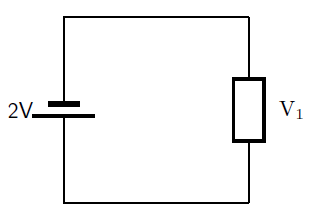| << Chapter < Page | Chapter >> Page > |
First we will measure the emf of the battery when no current is flowing. Make sure that the switch is open and the lightbulb is not glowing. This is how we check that there is no current flowing through the circuit. Then connect the voltmeter across the terminals of the battery. Make sure that the voltmeter is set to the largest scale when you first start measuring. Write down the voltage you measure. This is the emf. Disconnect the voltmeter.
Second we will measure the potential difference across the battery. This time, make sure the switch is closed and that the lightbulb is glowing. This means that there is current flowing through the circuit. Now connect the voltmeter again across the terminals of the battery. Again make sure that the voltmeter is set on its largest scale. Write down the voltage you measure. This is called the potential difference of the battery. How does it compare to the other value you measured when there was no current flowing?
Batteries all have some internal resistance to charges moving through them and therefore some work is required to move the charges through the battery itself. This internal resistance causes the potential difference across the battery terminals to be slightly less than the emf.
In the following exercises, we will assume that we have 'perfect' batteries with no internal resistance. In this special case, the potential difference of the battery and its emf will be the same. We can use this information to solve problems in which the voltages across elements in a circuit add up to the emf.
What is the voltage across the resistor in the circuit shown?

We have a circuit with a battery and one resistor. We know the voltage across the battery. We want to find the voltage across the resistor.
We know that the voltage across the battery must be equal to the total voltage across all other circuit components.
There is only one other circuit component, the resistor.
This means that the voltage across the battery is the same as the voltage across the resistor.
What is the voltage across the unknown resistor in the circuit shown?

We have a circuit with a battery and two resistors. We know the voltage across the battery and one of the resistors. We want to find that voltage across the resistor.
We know that the voltage across the battery must be equal to the total voltage across all other circuit components that are in series.
The total voltage in the circuit is the sum of the voltages across the individual resistors
Using the relationship between the voltage across the battery and total voltage across the resistors
What is the voltage across the unknown resistor in the circuit shown?

We have a circuit with a battery and three resistors. We know the voltage across the battery and two of the resistors. We want to find that voltage across the unknown resistor.
We know that the voltage across the battery must be equal to the total voltage across all other circuit components that are in series.
The total voltage in the circuit is the sum of the voltages across the individual resistors
Using the relationship between the voltage across the battery and total voltage across the resistors
What is the voltage across the parallel resistor combination in the circuit shown? Hint: the rest of the circuit is the same as the previous problem.

The circuit is the same as the previous example and we know that the voltage difference between two points in a circuit does not depend on what is between them so the answer is the same as above .
We have a circuit with a battery and five resistors (two in series and three in parallel). We know the voltage across the battery and two of the resistors. We want to find that voltage across the parallel resistors, .
We know that the voltage across the battery must be equal to the total voltage across all other circuit components.
Voltages only add for components in series. The resistors in parallel can be thought of as a single component which is in series with the other components and then the voltages can be added.
Using the relationship between the voltage across the battery and total voltage across the resistors

Notification Switch
Would you like to follow the 'Siyavula textbooks: grade 10 physical science [caps]' conversation and receive update notifications?